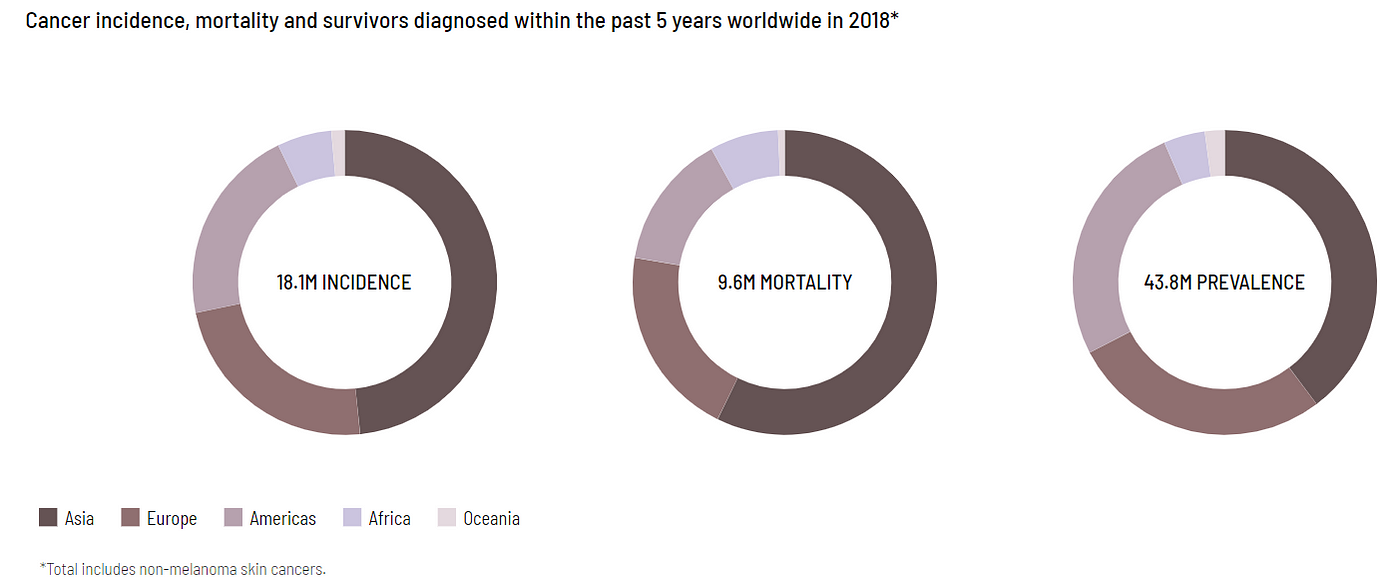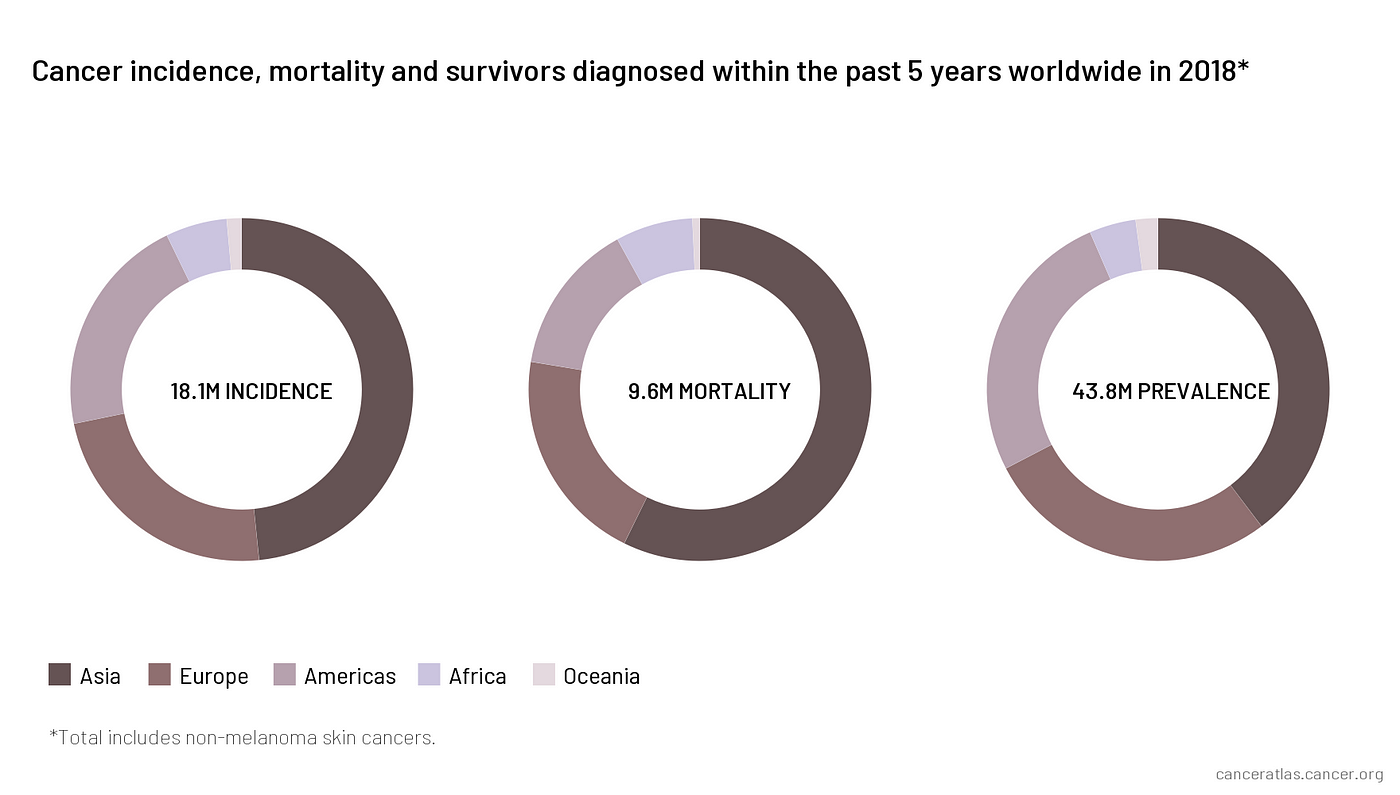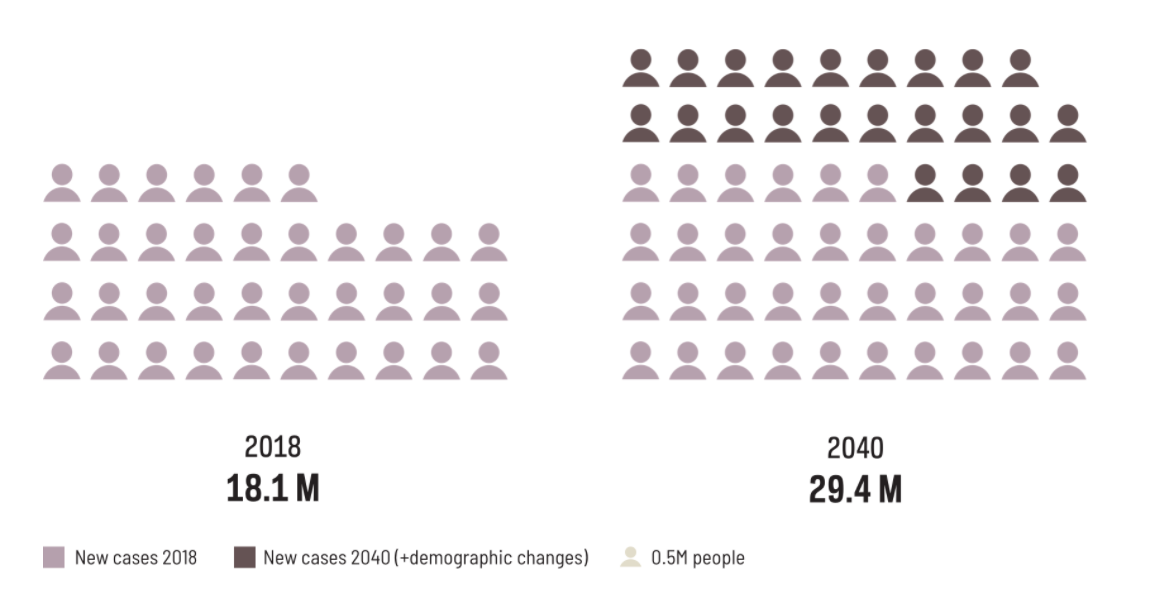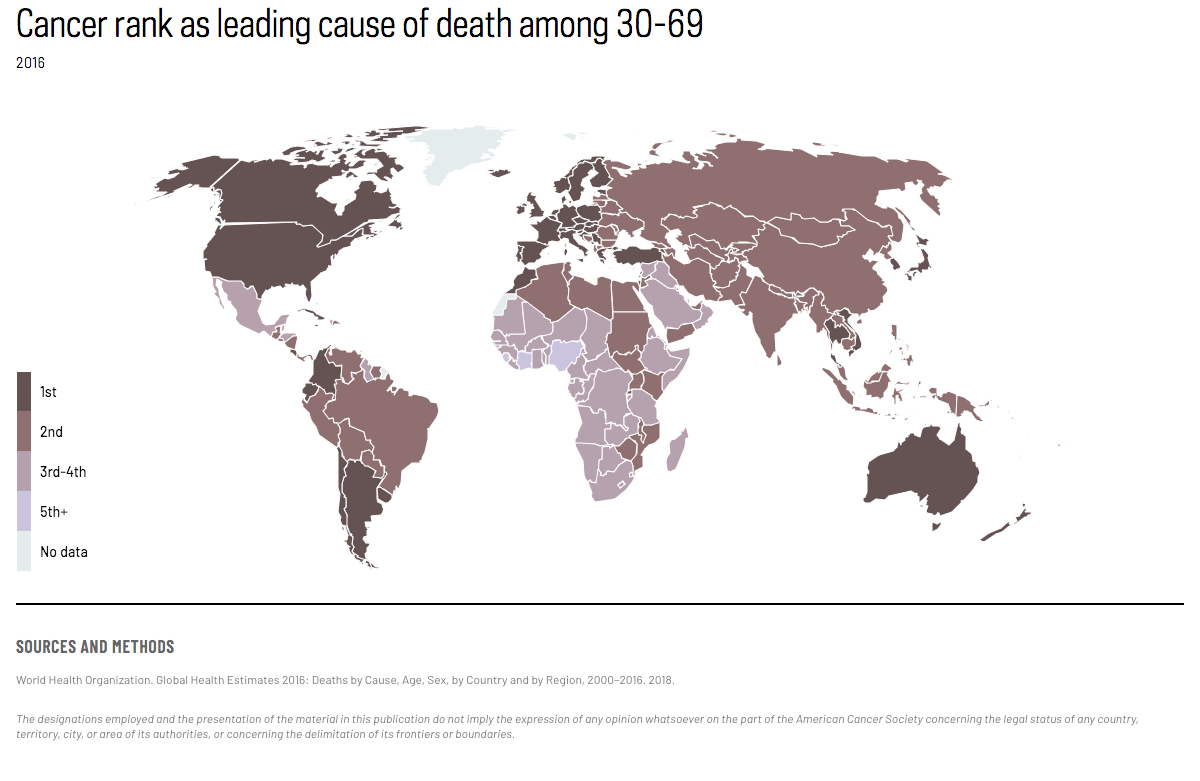Cancer Atlas
2018
Key messages:
Key messages:
- Worldwide, there were an estimated 18.1 million cases and
- 9.6 million cancer deaths in 2018 (including non-melanoma skin cancers),
- In addition, there were 43.8 million persons living with cancer in 2018 who were diagnosed within the last 5 years.
- with one in four men (25%) and
- one in five women (20%) developing the disease,
- and one in eight men (12,5%) and
- one in eleven women (9%) dying from it. (Figure 1)
- Half of the new cancer cases and cancer deaths in the world occur in Asia.
Cancer is a major public health and economic issue and its burden is set to spiral. With over 18 million cases in 2018, we can expect 29 million cases by 2040 due to the aging and growth of the population.
Worldwide, there were an estimated 18.1 million cases and 9.6 million cancer deaths in 2018 (including non-melanoma skin cancers), with one in four men and one in five women developing the disease, and one in eight men and one in eleven women dying from it. (Figure 1) In addition, there were 43.8 million persons living with cancer in 2018 who were diagnosed within the last 5 years. Half of the new cancer cases and cancer deaths in the world occur in Asia. (Figure 2)
Figure 1:
Percentage (%) of males and females developing and dying from cancer worldwide in 2018*

*Total includes non-melanoma skin cancers. In 2018, 21% of males worldwide will develop cancer in their lifetime. 13% of males worldwide die from the disease. 18% of females worldwide will develop cancer in their lifetime. 9% of females worldwide die from the disease.
Figure 2

Figure 2. Cancer incidence, mortality and survivors diagnosed within the past 5 years worldwide in 2018.* *Total includes non-melanoma skin cancers. In 2018, there were 18.1 million cancer cases. 48.4% were in Asia, 23.4% in Europe, 21% in Americas, 5.8% in Africa, and 1.4% in Oceania. In 2018, there were 9.6 million cancer deaths. 57.3% were in Asia, 20.3% in Europe, 14.4% in Americas, 7.3% in Africa, and 0.7% in Oceania. In 2018, there were 43.8 million cancer survivors diagnosed within the past 5 years. 39.7% were in Asia, 27.7% in Europe, 26.1% in Americas, 4.4% in Africa, and 2.1% in Oceania.
The global cancer burden is dominated by Europe, China, and Northern America.
China, with the largest population size in the region and worldwide — 1.4 billion inhabitants, representing 19% of the global population in 2018 — has the greatest global proportion of new cases (4.3 million cases, 24% of the total) and deaths (2.9 million deaths, 30%).
Northern America is second in terms of new cases (2.4 million, 13%), and fourth for cancer deaths (0.7 million, 7%).
Close to one fourth of all new cases globally (4.2 million) and one fifth of deaths (1.9 million) occur in Europe, despite the region representing less than one tenth of the global population.
“An inclusive and coordinated large-scale global response to fight cancer is overdue. Further delays will mean needless deaths, worsening inequities, and a failure to realize health, economic, and societal benefits.
Rifat Atun, global health systems expert, and Franco Cavalli, medical oncologist
For both sexes combined worldwide, lung cancer continues to be the most commonly diagnosed cancer (2.1 million, 12% of the total) (Figure 3) and the leading cause of cancer death (1.8 million, 18%) because of its poor prognosis. Female breast cancer is the second most common cancer overall (2.1 million, 12%) but the fifth leading cause of cancer death (627,000, 7%) because of its relatively favorable prognosis. As
such, it is the most prevalent cancer worldwide (6.9 million women living within 5 years of their breast cancer diagnosis). Colorectal cancer is the third most frequently-diagnosed cancer globally, but second only to lung cancer in terms of mortality (1.8 million cases and 881,000 deaths). Prostate cancer is the fourth most frequently diagnosed cancer, while stomach and liver cancer remain major causes of cancer death in 2018.
Figure 3

Cancer incidence, mortality and survivors diagnosed within the past 5 years: top 5 cancer sites in 2018 worldwide for both sexes combined
*Total includes non-melanoma skin cancers.
Figure 3Cancer incidence, mortality and survivors diagnosed within the past 5 years: top 5 cancer sites in2018 worldwide for both sexes combined*Total includes non-melanoma skin cancers.Top CancersLungBreastColorectumProstateStomachLiverThyroidOthercanceratlas.cancer.org
Figure 3. Cancer incidence, mortality and survivors diagnosed within the past 5 years: top 5 cancer sites in 2018 worldwide for both sexes combined (total includes non-melanoma skin cancers). In 2018, there were 18.1 million total cancer cases (including non-melanoma skin cancers). 12% were lung, 12% breast, 10% colorectum, 7% prostate, 6% stomach, and 54% other. There were 9.6 million total cancer deaths (including non-melanoma skin cancers). 18% were lung, 7% breast, 9% colorectum, 8% stomach, 8% liver, and 49% other. There were 43.8 million total cancer survivors who had been diagnosed within the past five years (including non-melanoma skin cancers). 5% were lung, 16% breast, 11% colorectum, 8% prostate, 5% thyroid, and 55% other.
Lung cancer is the most commonly diagnosed cancer and the leading cause of cancer death worldwide.
Based on projected population aging and growth, the global burden of cancer is set to increase by more than 60% by 2040, from 18.1 million new cases in 2018 to a predicted 29.4 million cases in the year 2040. (Figure 4)
More broadly, cancer has become a leading cause of death over the last few decades. In terms of premature mortality (defined as death in ages 30–69 years), in the year 2016, cancer was the leading cause of death in 55 (largely high-income) countries, but second (mainly to cardiovascular disease) in an additional 79 countries. (Map 1) With rates of cardiovascular mortality in decline in many countries due to highly successful prevention and treatment, cancer is set to become the leading barrier to increasing life expectancy in this century.
Figure 4
Number of new cancer cases in 2018 vs. 2040: impact of demographic projections by 2040

In 2018, and estimated 18.1 million cancer cases will occur worldwide. In 2040, an estimated 29.4 million cancer cases will occur, with the increase based solely on demographic changes.
Based on population growth and aging, the global cancer burden will grow to 29.4 million cases annually in 2040 (assuming global rates in 2018 remain unchanged).
Cancer rank as leading cause of death among 30–69

Cancer ranks as the first or second leading cause of premature death (among those 30–69 years of age) in 134 countries of the world.
Page Sources
Quote:
Atun R, Cavalli F. The global fight against cancer: challenges and opportunities. Lancet. 2018;391:412–413.
Text:
Bray F, Ferlay J, Soerjomataram I, Siegel RL, Torre LA, Jemal A. Global Cancer Statistics 2018: GLOBOCAN Estimates of Incidence and Mortality Worldwide for 36 Cancers in 185 Countries. CA Cancer J Clin. 2018. https://onlinelibrary.wiley.com/doi/full/10.3322/caac.21492.
Ferlay J, Colombet M, Soerjomataram I, et al. Estimating the global cancer incidence and mortality in 2018: GLOBOCAN sources and methods. Int J Cancer. 2018 Oct 23. doi: 10.1002/ijc.31937.
Ferlay J, Ervik M, Lam F, et al. Global Cancer Observatory: Cancer Today. Lyon, France: IARC, 2018. Available from: https://gco.iarc.fr/today.
World Health Organization. Global Health Estimates 2016: Deaths by Cause, Age, Sex, by Country and by Region, 2000–2016. 2018.
Map:
World Health Organization. Global Health Estimates 2016: Deaths by Cause, Age, Sex, by Country and by Region, 2000–2016. 2018.
Figures 1–4:
Estimates include non-melanoma skin cancers.
Ferlay J, Ervik M, Lam F, et al. Global Cancer Observatory: Cancer Today. Lyon, France: IARC, 2018. Available from: https://gco.iarc.fr/today.
Originally published at https://canceratlas.cancer.org.
PDF version
chrome-extension://efaidnbmnnnibpcajpcglclefindmkaj/viewer.html?pdfurl=https%3A%2F%2Fcanceratlas.cancer.org%2Fwp-content%2Fuploads%2F2019%2F09%2FCA3_TheBurdenofCancer.pdf&clen=1065795&chunk=true












